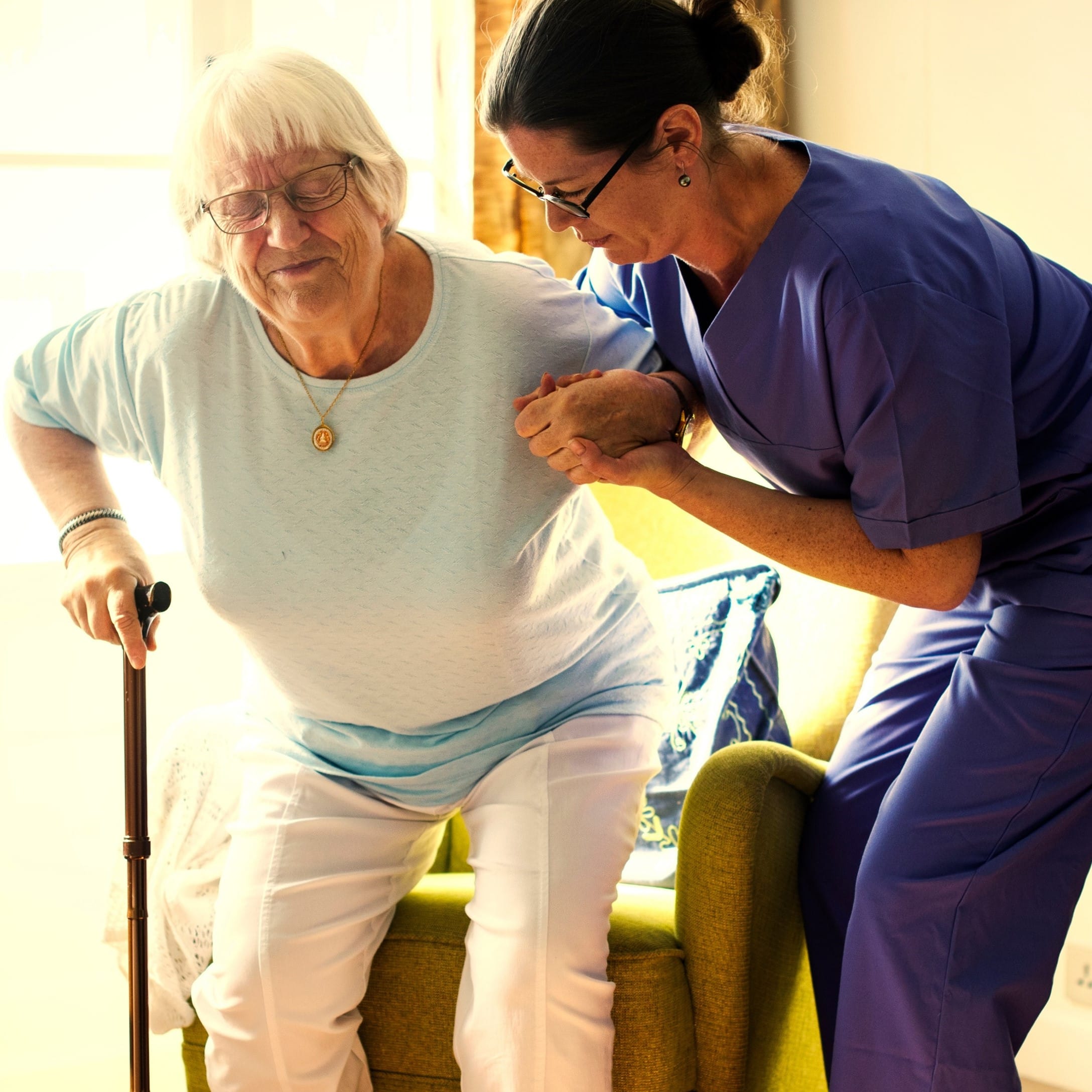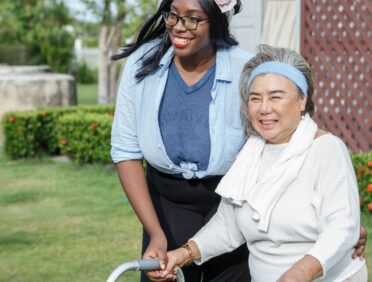The importance of proper moving and handling in caregiving
Whilst there are many aspects of providing care for those who need it, one of the elements that caregivers are going to need to get to grips with, is the handling and moving of people.
It may seem like it is relatively straightforward and with minimal need for training or guidance, however, this couldn’t be further from the truth. If moving people isn’t approached in the right way then it can lead to several possible issues and outcomes.
Not only can it hurt the person who is being moved, who may often be a vulnerable person, but it can also have a negative impact on the care provider who is moving them too.
All in all, this comes together to show that there is a real need for proper moving and handling in caregiving. So, let’s look at it in some more detail.
Key principles of moving and handling in caregiving
When it comes to moving and handling caregiving there are several principles that need to be identified and followed to keep all the parties involved as safe as possible.
First, you should always assess the situation and ensure that you are not going to face any additional risks when you are moving the person. Then you need to think about your own body and whether or not you are physically going to be able to complete the lift on your own.
Thirdly, you need to consider what position you are in now, that they are in now and what they need to end up in. Plan and think about the route and how may be best to approach what needs to happen.
After that, you need to ensure that the person that you are moving is ready to be moved, after all, you should be treating them with respect and with attention to their needs and feelings.
Once you have completed these steps, you are going to be ready to move the person safely and ensure that they are comfortable in their new position and location.
You can break down the process of moving someone and ensure that these key principles are met by following a variety of steps that relate to moving a person from one location to another. There are 10 steps in total and each one is as important as the others to be met.
Step 1: Know the Regulations
Whilst regulations may feel that they cause somewhat of a headache it is important to recognise that they are an important part of the care process and are there to ensure that both carers and the people that they provide care to are safe and well-treated.
UK Health and Safety legislation
When it comes to lifting people and moving people whilst care is given, two main pieces of legislation need to be understood and adhered to. These are the Health and Safety at Work Act and Manual Handling Operations Regulations.
Health and Safety at Work Act and its implications for caregivers
In care settings, health and safety is more than just aimed at keeping those who require care safe, it also ensures that the caregivers who are providing the care to them are as safe as possible too. The Health and Safety at Work Act ensures that they do not have to deal with injuries that could impact their ability to work, or even to go about their everyday life.
It is also worth noting that another key aspect of health and safety at work is that it is there to ensure that those who are being given care are treated in a way that is going to ensures that they are respected and looked after.
Unsafe health and safety practices, which does include manual handling, can have a huge impact on the people being lifted and the people doing the lifting too.
Manual Handling Operations Regulations and their requirements
The second piece of relevant legislation that applies to care is the Manual Handling Operations Regulations 1992. Manual handling can cover not only the moving and lifting of objects but, particularly in care settings, people too. The main aim of manual handling is to ensure that the load is lifted, carried and placed down in a way that is safe for the person lifting, and, where required the person being lifted too.
It gives guidance on the right way to lift and how to properly plan and prepare for any form of lifting, which will then also help the process to be much smoother too.
Step 2: Conduct a Risk Assessment
Whilst much of the lifting that is completed in care will be reactive, there are also times when it is going to be known that the person will need to be lifted, which means that it can be planned for. A risk assessment doesn’t have to be a long-drawn-out process long before the lift, sometimes you are going to need to perform a risk assessment there and then to ensure that it is safe.
Conduct a thorough risk assessment before any moving and handling task
The main thing to remember is that any risk assessment will need to be completed before the moving or handling task is approached. This should be as thorough and complete as time allows and should cover all the main aspects that could form a part of the risk assessment.
Assessing potential hazards and risks
Of course, the reason to conduct a risk assessment is to identify and assess the potential hazards and risks that could occur due to a particular action, in this case, lifting someone up. The caregiver should be able to consider what could happen during the lift and carry and what the implications of this could be.
Consider the individual’s needs and capabilities in the assessment
Another key part of moving someone into a care setting is considering their own needs. They should be considered and respected at all times and given the space and time that is needed for them to feel comfortable.
You can also think about their own capabilities too, they may be able to assist in the move, or they may not be able to provide any help or support. It really is down to them and what they can do physically.
Step 3: Choose the Right Technique
One of the main parts of manual handling of any types is the techniques that you use to move the person or the load. This includes lifting, transferring and repositioning. Some people may require more than one approach to be performed, depending on their need, however, you do need to be able to identify the technique that is going to work best for the situation that you find yourself in and the person who needs to be moved.
Moving and handling techniques:
- Lifting- when the person is lifted into the air and moved to a new position.
- Transferring- moving someone to a new position or location, usually by rolling them or sliding them.
- Repositioning- when you need to move someone from one position to another. This could be sitting, standing or lying down.
Choosing the appropriate technique for each situation
It is important to ensure that you always consider which technique is going to be most appropriate in the situation. You don’t have to be trying to move someone in a way that is not right either for them, you, their situation or their level of need.
This will mean that you need to understand exactly what each technique looks like and when they are most appropriate to be used.
The importance of using assistive equipment when needed
Assistive equipment is there to do just that, to assist people when they need it. This means that you should recognise their benefits and be able to understand what they will help with each time that they are used.
Many people are put off from using these pieces of equipment because they do take some time to set up and pack away, but they could be the difference between hurting the person you are moving, injuring yourself and simply being able to move them with ease.
Step 4: Proper Body Mechanics
One key aspect of manual handling and lifting someone is to be aware of proper body mechanics. This not only means your own body, but also the body of the person that you are lifting too.
Guidance on maintaining proper posture and body mechanics
When you are lifting or moving a person you need to be aware of your own body and how you are standing and moving,
The first thing that you need to be aware of is your posture. Holding the right posture and ensuring that your back has its natural curve will help to reduce the risk of a back injury and any form of back injury.
You should also be aware of the other key parts of your body and how they need to be held in order to ensure that they are not injured.
Avoiding strain on caregivers’ bodies and preventing injuries
You should always approach lifting someone up in a way that is going to avoid placing the caregiver’s body under any unnecessary strain. Of course, lifting someone up can create strain in your body, but, there are lots of ways to try and reduce this the best that you can.
One of these is to ensure that you utilise any tools and equipment that you may have on your premises, which are designed to reduce this level of stress and strain.
Lifting and transferring techniques that prioritise safety
Safety should always be the focus when it comes to moving someone. Not only safety for you but safety for them too. You do not want to find that the way that you are moving someone could be causing them more harm than good, especially if they are unable to tell you that this is the case.
Step 5: Communicate and Collaborate
When you work in care you need to make sure that you always communicate. The main person who you should be communicating effectively with is the person receiving the care. However, there are also others that you are going to need to communicate with and also collaborate with.
Importance of clear communication with the individual being moved
First of all, you need to make sure that you are providing the person who is being moved with clear communication on what is happening. They should be able to understand why they are being moved, where they are being moved to and why you are moving them.
Not only this, but you need to explain the process to them too. This may be something that you do before, to ensure that they feel informed, but also reiterate the steps during the process too. You may need to consider their level of understanding and ensure that you are giving them information that they can retain or understand.
A collaborative approach involving caregivers, individuals, and healthcare professionals
Care is something that involves lots of different people. Therefore it is something that should always be approached collaboratively. When you are moving someone, there is a good chance that you will not be doing this alone, therefore you need to work with those around you.
This may mean coming together to discuss the best way to move the person, thinking about the strengths of each person who is involved and discussing who will take on which part of the process.
Addressing individual preferences and needs during the moving and handling process
When you work in care you will soon realise that every person is different and will have their own needs that need to be recognised and met. This includes how you move them and handle them during the move.
You should be aware of the individual needs of each person before you even start to move them and you should also ensure that these are shared with anyone else who may be a part of the process too.
You should also ensure that the individual who is being moved can share their own preferences, even if these are not the norm, they may be in pain or have something that is impacting them right then at that moment, that will need to be taken into account.
Step 6: Preventing Musculoskeletal Disorders
The very nature of being a carer can mean that you are at a higher risk of developing a range of musculoskeletal disorders which can have a short-term and long-term impact on your quality of life.
It is down to you, as the carer, to find ways to ensure that you prevent these disorders from occuring, taking care of your health and wellbeing.
Common musculoskeletal disorders among caregivers
To prevent these musculoskeletal disorders from occurring, it is best to ensure that you identify what they are and what they can mean to you.
The most common musculoskeletal disorders that can occur among caregivers are:
- Lower back pain
- Neck pain
- Shoulder pain
- Tension neck syndrome
- Shoulder tendonitis and bursitis
- Impingement syndrome
- Frozen shoulder
- Tennis elbow
- Carpal Tunnel
Strategies for preventing injuries, such as maintaining fitness and practising self-care
The majority of injuries and disorders that can come from being a caregiver can be prevented. Of course, the main way to do this is to ensure that you follow the manual handling guidelines that apply to your job.
However, there are other things that you can do to ensure that you reduce the chance of them happening.
It is a good idea to ensure that you maintain your levels of fitness. Being a carer is an active job, which puts a high level of stress and strain on your body. If you try to keep your fitness levels up then you are going to find that it really helps to improve your everyday work and to ensure that you stay as healthy as possible, despite the physical demands of the role.
You should also ensure that you practice self-care regularly. Recognising when you may need to take a break, and, where possible, ensuring that this happens.
Recognising signs of strain and seeking medical attention when necessary
If you do think that you are showing signs of a strain or a disorder, then you need to ensure that you get medical advice. You may find that all you need to do is rest, as this will help you to recover. However, there are also likely to be times when you need medical assistance to get better.
It is important that you seek this help and that you listen to the guidance that is given to you, or else you could end up making the situation worse and leading to even more long-term problems.
Step 7: Maintain Dignity and Respect
Working as a carer and providing care to someone means that you need to always work towards maintaining the dignity and respect of the person who is being given the care. It doesn’t matter what task you are carrying out, this should always be your focus and play a part in all of the things that you do within your work.
Incorporating dignity and respect into moving and handling practises
The nature of handling someone and moving them can mean that their dignity and respect are at risk. After all, it is a physical act that is carried out on their body. Therefore, you need to ensure that all the moving and handling practices that you have in place are done in a way that focuses on the person and what they need.
Maintaining privacy and emotional comfort during transfers
Transferring and moving someone can lead to a variety of emotions for them. They may not want to be moved, they may find it embarrassing that they require this help and they may feel that they are being manhandled.
This means that you need to ensure that you recognise their emotions and how you can comfort them and address these emotions.
You also want to think about their privacy, what are they wearing, are what is covered over. If they are not, then you are going to want to find a way to ensure that this happens for them and that they do not feel that they have been exposed in any way.
Empowering individuals to participate in the moving and handling process
Whilst there may be some issues with the mobility of the person who you are moving, this does not mean that they cannot assist and participate in some way. You should speak to them about their circumstances and limitations, and share ideas on what the best approach may be to moving them.
You may find out that they are more able to help than you realise and that this can make the entire task much easier for both of you.
Step 8: Document and Evaluate
Whilst the physical act of moving someone is a key part of the process, you also need to make sure that you take the time to document and evaluate after the event too.
Keeping accurate records of moving and handling activities
You should keep a record of whenever you have moved or handled someone during your working time. This will ensure that should anything happen to you or them, there is a record of the time and date that it could have occurred.
Regular evaluation of moving and handling procedures for effectiveness
Another part of the process is thinking about and evaluating the procedures in your environment and whether or not they have been as effective as they can be. You may think that someone will work, only to find out, when you actually carry it out, that it is not quite right on the whole, or for that person.
Things should then be changed to ensure that they do work well and that best practices are shared with all relevant parties too.
How documentation contributes to compliance with UK regulations
Many parts of UK regulations show that you follow them and have a record to prove this. Therefore, showing that you follow correct manual handling processes should be a part of your manual handling process in itself.
Take the time to always ensure that you complete the relevant documentation and that it is stored in a way that meets GDPR and keeps data protected at all times.
Step 9: Continuous Improvement
No matter how long a company has been providing care services, or how long someone has been working in care, there is always improvement to be had. This comes in a variety of ways.
Continuous learning and improvement in moving and handling practises
Several practices relate to manual handling, and whilst these are largely the same, there is always a chance that they can be improved. The best way to do this is to take the time to learn more about the new approaches that have been put in place and see whether or not they are going to be applicable in your setting.
Stay informed about updates to regulations and best practices
Whilst you do not ever have to be an industry expert, it is always a good idea to ensure that you stay informed about the latest updates to the regulations and the best practices too. These will not always be appropriate to you in your work, but they can always help you to understand more about the industry as a whole.
There may also be some major changes to the regulations that govern care work, these will need to be understood and followed to ensure that you are doing your job in the right way and protecting the safety and privacy of those who are in your care.
The importance of prioritising safety and dignity in caregiving
Those people who require care are going to need to have their situation and circumstances understood. They should be treated in a way that prioritises their safety and that their dignity is always maintained and protected too.
This is particularly true if they are vulnerable, as this means that their dignity is even more important.
Step 10: Equipment and Training
Care is not an easy job and manual handling is not an easy part of delivering care to people. However, the good news for those that work as carers is that there are lots of pieces of equipment that are designed to make the job as easy as possible, there is also training that is delivered to ensure that those who work in care have the right knowledge to be able to do their job to the best of their ability.
The role of equipment in safe moving and handling
There are lots of different pieces of equipment that are designed to make moving and handling people all the easier. Seeing as they are designed to make things easier, it makes sense that they should be used as much as possible.
Some of the main pieces of manual handling equipment may include:
- Hoists
- Slings
- Slide sheets
- Transfer boards
- Turntables
- Lifting cushions
Mandatory training requirements under UK regulations
It is a legal obligation of employers to ensure that every staff member within their setting is trained and competent in manual handling. This is true for every industry, however, in care, this becomes even more important.
This should not be a one-off training course either, this should be a training course that is refreshed regularly, to ensure that every staff member is using it in their everyday work and keeping themselves and those that they provided care to, as safe as possible.
Stay updated with proper training and techniques
Owners and managers of care settings need to ensure that their staff members have access to the right training and techniques that are there to keep people safe when they are working. They should be delivered to heir training on a regular basis and should feel able to refresh the training should they need to.
Learn Q offer a wide range of courses for suitable for care givers, including:
For bulk buys of over 10 courses, discounts are applied.
Plus, you can save even more (over 50%) with our money saving bundles, including:











